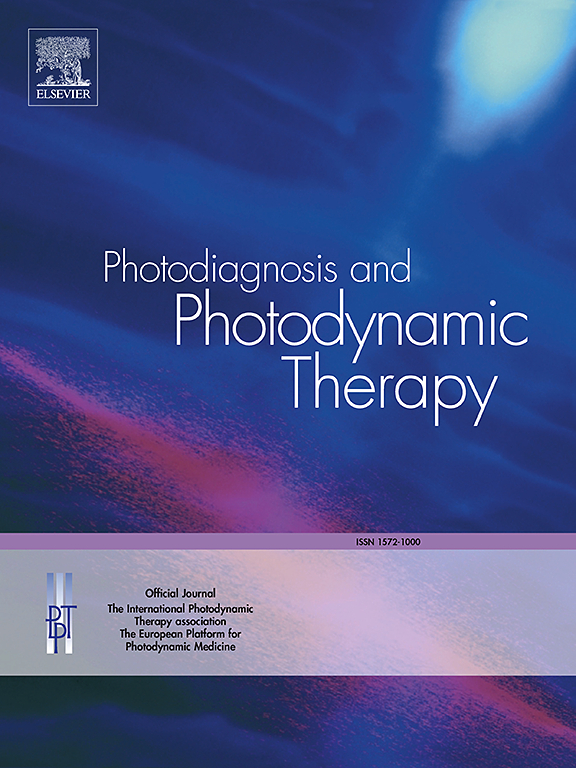Long-Term retrospective analysis of retinal pigment epithelium atrophy and secondary hyperplasia following verteporfin photodynamic therapy
IF 3.1
3区 医学
Q2 ONCOLOGY
引用次数: 0
Abstract
Purpose
To identify risk factors for retinal pigment epithelium (RPE) atrophy associated with verteporfin photodynamic therapy (PDT), with or without secondary RPE hyperplasia, and to evaluate long-term visual outcomes.
Materials and methods
This retrospective study analyzed 197 eyes of 180 patients who underwent verteporfin PDT between 2000 and 2023. Baseline demographic and clinical characteristics were evaluated.
Results
Among 197 eyes that underwent one or more sessions of PDT, PDT-induced RPE atrophy was observed in 2 eyes (2.4 %) with wet age-related macular degeneration (wet AMD) or polypoidal choroidal vasculopathy (PCV) and in 1 eye (3.8 %) with central serous chorioretinopathy (CSC). In contrast, 18 eyes (22.2 %) with myopic choroidal neovascularization (mCNV) developed PDT-induced RPE atrophy. Subgroup analysis revealed that in the mCNV group, patients with PDT-induced RPE atrophy were significantly younger (36.5 ± 13.7 years vs. 46.3 ± 12.8 years; P < 0.001) and underwent more PDT sessions (2.6 ± 1.8 vs. 1.5 ± 0.8; P < 0.001) than those without atrophy. Five patients developed secondary RPE hyperplasia, all from the mCNV group.
Conclusion
Verteporfin PDT rarely induces RPE atrophy in patients with wet AMD, PCV, and CSC. However, in patients with myopic CNV, PDT may occasionally cause alterations in the RPE, including both atrophy and secondary hyperplasia. While PDT-induced RPE atrophy was not a statistically significant predictor of best-corrected visual acuity at the final follow-up in the mCNV and wet AMD/PCV groups in the linear regression analysis, it was a significant factor in the CSC group.
维替泊芬光动力治疗后视网膜色素上皮萎缩和继发性增生的长期回顾性分析
目的探讨椎泊芬光动力治疗(PDT)伴或不伴继发性RPE增生的视网膜色素上皮(RPE)萎缩的危险因素,并评估长期视力结果。材料和方法本回顾性研究分析了2000年至2023年间接受维替泊芬PDT治疗的180例患者的197只眼。评估基线人口统计学和临床特征。结果在197只接受一次或多次PDT治疗的眼睛中,2只(2.4%)患有湿性年龄相关性黄斑变性(wet AMD)或息肉样脉络膜血管病变(PCV), 1只(3.8%)患有中心性浆液性脉络膜视网膜病变(CSC)。相比之下,18只(22.2%)患有近视脉络膜新生血管(mCNV)的眼睛出现pdt诱导的RPE萎缩。亚组分析显示,在mCNV组中,pdt诱导的RPE萎缩患者明显更年轻(36.5±13.7岁vs 46.3±12.8岁;P & lt;0.001),接受了更多的PDT治疗(2.6±1.8 vs. 1.5±0.8;P & lt;0.001)。5例患者发生继发性RPE增生,均来自mCNV组。结论维替泊芬PDT对湿性AMD、PCV和CSC患者的RPE萎缩影响较小。然而,在近视CNV患者中,PDT可能偶尔引起RPE的改变,包括萎缩和继发性增生。虽然在线性回归分析中,pdt诱导的RPE萎缩并不是mCNV和湿性AMD/PCV组最终随访时最佳矫正视力的统计学显著预测因素,但它在CSC组中是一个显著因素。
本文章由计算机程序翻译,如有差异,请以英文原文为准。
求助全文
约1分钟内获得全文
求助全文
来源期刊

Photodiagnosis and Photodynamic Therapy
ONCOLOGY-
CiteScore
5.80
自引率
24.20%
发文量
509
审稿时长
50 days
期刊介绍:
Photodiagnosis and Photodynamic Therapy is an international journal for the dissemination of scientific knowledge and clinical developments of Photodiagnosis and Photodynamic Therapy in all medical specialties. The journal publishes original articles, review articles, case presentations, "how-to-do-it" articles, Letters to the Editor, short communications and relevant images with short descriptions. All submitted material is subject to a strict peer-review process.
 求助内容:
求助内容: 应助结果提醒方式:
应助结果提醒方式:


